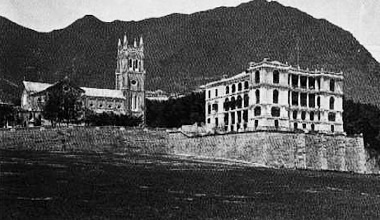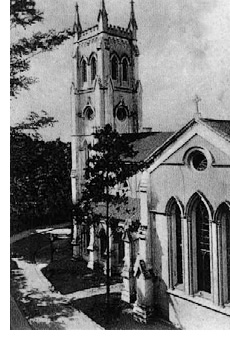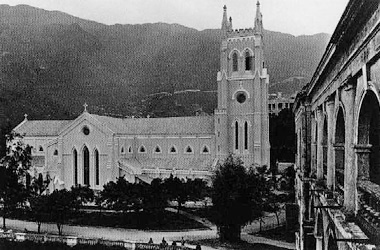FROM THE FOUNDATION TO THE SECOND WORLD WAR
On 25th January 1841, as naval officers stepped ashore on a 'barren island', Queen Victoria's government could not have foreseen the rapid growth of the settlement, founded in Her Majesty's name, into today's international city on the crossroads of East and West.

It was an era of colonial expansion and the missionary zeal to spread Christianity was running high. Yet six years were to elapse before the foundation stone could be laid for a church for the Colony of Victoria, Hong Kong. The Cathedral Church of St John the Evangelist is a testament to the dedication and determination of the early residents and its leaders. They had begun to raise funds for a church even before they left Macau to settle in Hong Kong.
JAPANESE OCCUPATION FROM 1941 TO 1945
 In September 1939 the Second World War began. As a British Colony, Hong Kong supported Britain's war effort in Europe while coping with local problems of refugees from China, civilian evacuation and emergency measures.
In September 1939 the Second World War began. As a British Colony, Hong Kong supported Britain's war effort in Europe while coping with local problems of refugees from China, civilian evacuation and emergency measures.
Japan, an ally during World War One, had emerged as a Far Eastern Power and by 1937, had become embroiled in conflict with China. On the morning of 8th December 1941, the day after their attack on Pearl Harbour, the Japanese attacked Hong Kong.
Despite what must have appeared as a desperate and inevitable situation, on Christmas morning 1941 the Reverend Alaric P. Rose took the morning service in St John's with a congregation of one hundred, whilst shelling continued on the island. That afternoon, the Governor of Hong Kong, Sir Mark Young, made the decision to surrender to the Japanese after a hard fought battle, which had lasted for less than three weeks.
The occupation lasted for nearly four years, but the spiritual life of the church was kept alive. In the internment camp for the military personnel at Shamshuipo the chaplains of the armed forces conducted regular services in an ad hoc chapel. The wooden reredos in St Michael's chapel is a memento of these times. The nationals of countries at war with Japan were interned on the Stanley peninsula, including the grounds of St. Stephen's College. A group of clergy maintained a programme of united and international services of worship and Holy Communion was celebrated every Sunday.
FROM THE END OF THE SECOND WORLD WAR UNTIL TODAY

On 9th September 1945, the first service after the arrival of the Royal Navy was held in the Cathedral. For many years afterwards the Sunday nearest to 28th August was celebrated as Liberation Sunday, commemorating these events. Shortly afterwards Bishop R.O. Hall returned to Hong Kong from West China. Alaric Rose (who with his wife, Mary, had spent the previous four years in the Stanley Internment Camp), was appointed Dean. Together the Bishop and the Dean immediately set about making plans to restore the Cathedral and rebuild the congregation.

OUTREACH
In the early days, St John's Cathedral was the spiritual centre of a vast area which included China and Japan. The matter of educating and training young men to serve this diocese as well as ensuring the spiritual well being of Victoria residents was high among diocesan priorities. When the Diocese of Victoria was twenty three years old, a new diocese for North China was created and in subsequent years, further divisions occurred. The Diocese of Hong Kong, as it is today, dates from 1951.
OUTREACH AND COMMUNITY
Time and events have wrought many changes and these are reflected in the nature of St John's outreach and community over the years. The extent of St John's outreach in the earlier part of the century is difficult to ascertain, but the opening of the Old Hall in 1921 certainly must have improved the scope for community activities, such as winter dances for members of H.M. Navy.
The Cathedral had its own Evangelist and Mission Committee in 1931 which, among other things, conducted appeals for clothing and medical supplies for the lepers at Pak Hoi and the missions in China. In the north transept of the Cathedral a mission corner was created, reminding the congregation of their obligation to support the missions in China. The Mothers' Union organised working parties to make clothes for orphans and needy children. A Diocesan orphanage was established by Bishop Hall in 1937 at Taipo. This still exists, although was re-named St. Christopher's Home after the war. A Women's Guild and a Men's Society also existed before the war.
Until the Second World War, little organised welfare activity existed in Hong Kong. Homelessness, destitute children, refugees, poverty and illiteracy were familiar problems after each wave of civil war in China. In the ten years prior to the Japanese invasion the population had virtually trebled. By 1938, in response to the pressing needs of incoming refugees fleeing from the Japanese invasion of Kwantung province, a planned programme of social welfare was begun. This set the style for the church's future response. Bishop Hall was instrumental in this initiative.
After the war, Hong Kong had enormous problems with housing and social welfare and St John's itself faced a major task in restoration and rebuilding a congregation. The community responded to the church's appeal for restoration funds, and half of the sum required was raised by 1947.
In 1949 the People's Republic of China was born and St John's celebrated its centenary. An influx of political refugees from China had further swelled the population of Hong Kong, which as a result began developing into a major industrial and commercial centre.
The church, led by Bishop Hall, co-operated with other groups in caring for the rapidly growing population. The St James' Settlement in Wanchai was one such project. This began as a club for boys and girls in a Wanchai temple in 1949, later moving to a Nissen hut on an adjacent site two years later. With emphasis on literacy and the acquisition of practical and technical skills, the Settlement outgrew the Nissen hut and a later multi-storey replacement, to celebrate its recently completed addition of an eleven-storey multi-service community building adjacent to the temple where it began so modestly. For quite a number of years St John's has taken a special interest in the Settlement and two representatives of the Council sit on the executive committee.
The Hong Kong Government has steadily increased its commitment to social welfare programmes over the years, but there is still plenty of scope for improvement and for private initiative. Many areas of need still exist in Hong Kong. It is in these areas that members of St John's work mostly today, either as individuals or in groups - but from time to time they also bring to notice needs in areas outside Hong Kong.
The CLARES is a Cathedral Women's Group, who meet on a weekday morning. The group was founded in 1962 and serves the church and the community through all manner of voluntary work. This may be with the elderly residents in the China Coast Community which had its origin in the work of Dean Sidebotham and a group of parishioners, or in organising Christmas parcels for needy children or selling their own handicraft products to raise funds.
Other Cathedral members take time to help the elderly in the Christian Family Service Centre's Day Care Centre at Kwun Tong. Voluntary workers give comfort and companionship for the sick and their families, the shut-in, and provide nursing care and therapy.
Perhaps the most significant fund-raising event organised by members of St John's is the annual Michaelmas Fair. For a number of years the entire proceeds of the Fair have been distributed to various charities and welfare organisations in Hong Kong.
Men, women and children of many nationalities and with a variety of talents reach out in many directions enriching St John's and the community by sharing their gifts in an international spirit of goodwill and fellowship.
For the children and young people at St John's, Sunday School is grouped according to age and meets in the Fanny Li Hall on Sundays. The 36th Hong Kong Scouts, established in 1955, meet weekly in the Fanny Li Hall. Several other self help groups also use the Cathedral Halls for regular meetings throughout the week. Throughout the year, Bible study groups meet regularly.
The Filipino Christian Fellowship has been meeting regularly for Bible Study, singing and fellowship for the past five years. More than one fifth of the non-Chinese population in Hong Kong are Filipinas, many of whom have come in the past ten years to work as domestic helpers in the more affluent Chinese and expatriate homes. Although many are well educated and some are university graduates or even teachers, this type of employment in Hong Kong has enabled them to contribute to their families in the Philippines in a way that would not otherwise be possible. Here at St John's, HELP for Domestic Workers (HELP) and Mission for Migrant Workers (MFMW) are our outreach ministries to provide advice and assistance to migrant workers or foreign domestic workers in need.
St John's runs its own full-time Counselling Service. Begun in 1978, the service exists to respond to the contemporary interest in and individual need of personal and relational growth and development. A training programme for courses in personal growth, human relations and counselling is provided.
Near the Li Hall the Cathedral Bookstore is to be found. Due to the hard work of various volunteers, the bookstore has grown from a single shelf into a lock-up shop. The store aims to make available a comprehensive range of Christian reading material, not otherwise available in Hong Kong, together with the Bibles and service books used in the Cathedral. It now also stocks a wide range of children's books, gift items and greeting cards for all ages.
The Cathedral also maintains a small library of religious books in the Administration complex, which is available to anyone who is interested. The library is in the charge of the Cathedral Librarian, a voluntary post.
In Touch (former name: St John's Review), the magazine for St John's and its daughter churches, is circulated to subscribers in Hong Kong and abroad. St John's Review was started by the Revd H.V. Koop in 1929 to supersede the former Cathedral Notes. In 2014, St John's Review was renamed In Touch.
Music for the public has, for some time, featured in Cathedral life with regular weekly lunchtime concerts. Evening recitals of many kinds are held throughout the year, vocal or instrumental.
Throughout the year, special services are held in the Cathedral to observe certain community occasions such as St John's Ambulance Sunday and Remembrance Sunday. Formerly, Aviation and Seafarers services were also held.
Since its inception, the great majority of the services in the Cathedral have been conducted in English. Special Diocesan services have been conducted in Cantonese or Mandarin. The services in English comprise the services at 8.00am, 9.00am, 11.45am and 5.00pm on every Sunday. The Cantonese service is held weekly on Saturday 6.00pm. On Sundays, St John's conducts services in Mandarin at 10.30am and services in Filipino at 1.30pm. During the week, Holy Communion is celebrated every day.